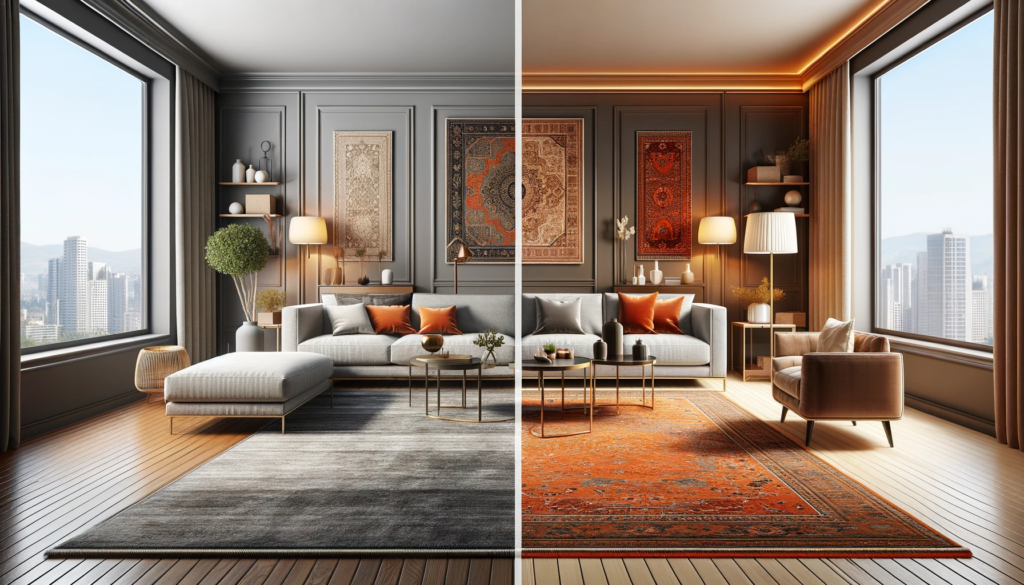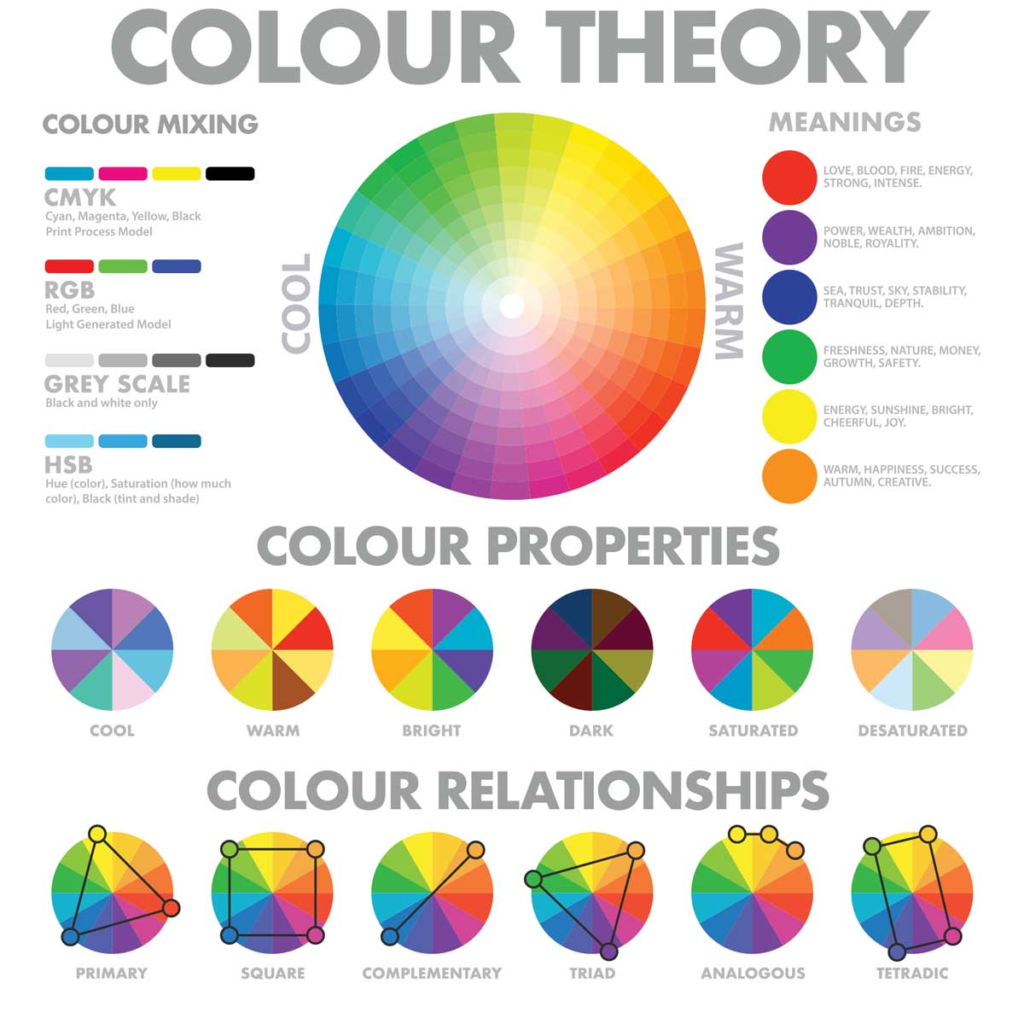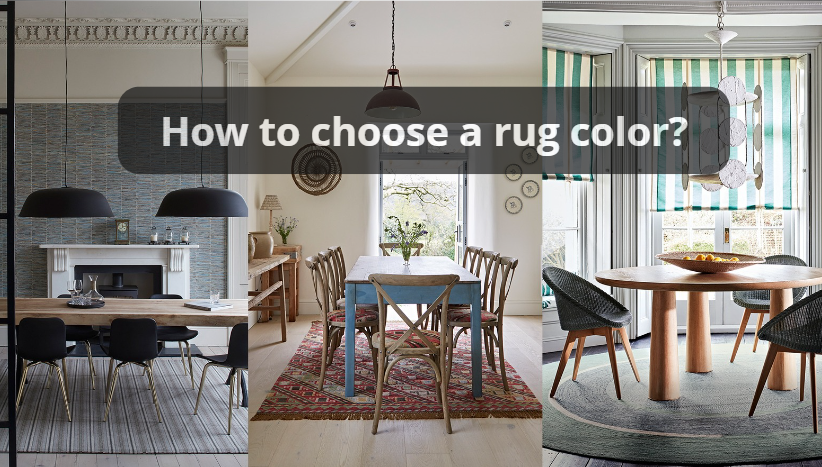How to choose a rug color?
1. Consider the Existing Color Palette
- Coordinate with Wall Color: If your walls are a neutral color, you have more flexibility with rug color. For brightly colored or patterned walls, choose a rug that complements or tones down the room.
- Match with Furniture: Look at the colors of your furniture. A rug can either blend with your existing furniture or provide a contrasting color to add interest.
2. Determine the Mood and Style
- Warm Colors: Reds, oranges, and yellows create a warm, inviting atmosphere.
- Cool Colors: Blues and greens can make a room feel calm and serene.
- Neutral Colors: Beige, gray, and taupe are versatile and can work in almost any room, providing a sophisticated look.
3. Assess the Room’s Function
- High Traffic Areas: For areas with a lot of foot traffic, darker colors or patterns can help hide dirt and wear.
- Living and Dining Rooms: Consider durability and ease of cleaning, especially if you have kids or pets.
4. Size and Pattern
- Small Rooms: Lighter colors can make a room feel larger and more open.
- Large Rooms: Darker colors can make a vast space feel cozier.
- Patterned Rugs: Patterns can add visual interest but should not clash with other patterns in the room. They can also be great for hiding stains.
5. Light and Ambiance
- Natural Light: Rooms with plenty of natural light can handle darker rugs, whereas rooms with less natural light might benefit from lighter colors to brighten the space.
- Artificial Light: Consider the type of lighting (warm or cool) as it will affect how the rug color appears.
6. Personal Preference
- Favorite Colors: Choose colors you love and will enjoy seeing every day.
- Trends vs. Timeless: Decide whether you want a trendy color that might go out of style or a classic color that will stand the test of time.
7. Test Samples
- Swatches: If possible, bring home swatches or small samples of rugs to see how they look in your room with your lighting and existing decor.
8. Practical Considerations
- Maintenance: Light-colored rugs might show stains more easily, so think about how much maintenance you’re willing to commit to.
- Material: Different materials reflect colors differently; wool might look different from synthetic fibers.
Examples:
- Neutral Palette: A gray or beige rug works well if you have a lot of color in your room already, keeping the focus on other elements.
- Bold Choice: A deep blue or rich red rug can be a statement piece in a room with neutral walls and furniture.
- Patterned Rug: Stripes, geometric patterns, or florals can add depth to a room and tie together various elements.
By considering these factors, you can choose a rug color that enhances your space, suits your lifestyle, and reflects your personal taste.

Why do you need a rug in a modern dining
room?
A rug in a modern dining room serves several purposes, both practical and aesthetic. Here are some reasons why having a rug in this space can be beneficial:
Aesthetic Appeal
- Define the Space: In open floor plans, a rug can help delineate the dining area from other spaces, such as the living room or kitchen.
- Add Texture and Color: A rug introduces additional layers of texture and color, enhancing the visual interest of the room.
- Tie Elements Together: A well-chosen rug can harmonize the various elements of your dining room, such as the table, chairs, and decor.
Comfort
- Underfoot Comfort: A rug provides a softer surface underfoot, making the dining experience more comfortable, especially if you spend a lot of time at the table.
- Acoustic Benefits: Rugs help absorb sound, reducing noise levels and creating a more intimate, cozy atmosphere in the dining room.

Practicality
- Protect the Floor: A rug can protect hardwood, tile, or other types of flooring from scratches, scuffs, and spills.
- Stabilize Furniture: Rugs can help keep dining chairs in place, preventing them from sliding around on hard surfaces.
Warmth
- Insulation: Rugs add an extra layer of insulation, helping to keep the dining area warm, especially in cooler climates or during winter months.
Style Cohesion
- Modern Design: In a modern dining room, a rug can contribute to the overall style by adding contemporary patterns, sleek designs, or bold colors that complement modern decor.
Comfort for Bare Feet
- Barefoot Dining: If you and your guests often dine barefoot or in socks, a rug provides a much warmer and more pleasant surface than a hard floor.

Color scheme: how to understand which colors suit each other
The color wheel is a fundamental tool for understanding color relationships. It includes primary colors (red, blue, yellow), secondary colors (green, orange, purple), and tertiary colors (mixes of primary and secondary colors).
There are several classic color schemes that you can use as a guide:
- Monochromatic: Uses variations in lightness and saturation of a single color. This scheme is simple and elegant.
- Example: Light blue, medium blue, dark blue.
- Analogous: Uses colors that are next to each other on the color wheel. This scheme is harmonious and often found in nature.
- Example: Blue, blue-green, green.
- Complementary: Uses colors that are opposite each other on the color wheel. This scheme is high-contrast and vibrant.
- Example: Blue and orange.
- Split-Complementary: Uses a base color and the two colors adjacent to its complementary color. This scheme offers contrast with less tension than a direct complementary scheme.
- Example: Blue, yellow-orange, and red-orange.
- Triadic: Uses three colors that are evenly spaced around the color wheel. This scheme is balanced and vibrant.
- Example: Blue, red, and yellow.
- Tetradic (Double-Complementary): Uses two pairs of complementary colors. This scheme is rich and offers plenty of contrast.
- Example: Blue, orange, green, and red.
3. Color Temperature
- Warm Colors: Reds, oranges, and yellows evoke warmth and energy.
- Cool Colors: Blues, greens, and purples create a calm, relaxing atmosphere.
- Balancing warm and cool colors can add depth and interest to a room.
4. Neutral Colors
- Neutrals: White, gray, beige, and black can balance out more vibrant colors and add sophistication.
- Using Neutrals: Incorporate neutrals to tone down bold colors or as a primary color palette with pops of color for interest.
FAQs
Should a rug be darker or lighter than the floor?
Deciding whether a rug should be darker or lighter than the floor depends on several factors, including the overall design of the room, the effect you want to achieve, and practical considerations. Here are some guidelines to help you make the best choice:
Darker Rug on Lighter Floor:
Creates a striking contrast that can define the space and make the rug stand out.
Helps anchor the room, making it feel more grounded.
Works well in modern or contemporary spaces where bold contrasts are desired.
Lighter Rug on Darker Floor:
Offers a softer, more subtle contrast.
Can make a room feel larger and more open.
Adds brightness to the space, which can be particularly useful in rooms that need a lighter touch.
Should a rug match wall color?
While a rug doesn’t have to exactly match the wall color, coordinating the two can create a harmonious and cohesive look in a room.
Choose a rug that complements the wall color rather than matches it exactly. For instance, if your walls are a soft blue, a rug with complementary colors like orange or yellow can create a balanced and pleasing look.
Should carpet be lighter or darker than couch?
Deciding whether a carpet (or rug) should be lighter or darker than your couch depends on several factors, including the desired aesthetic, room size, lighting, and the overall design scheme.
Darker Carpet, Lighter Couch:
Creates a strong contrast, making the couch stand out as a focal point.
Can ground the room and add a sense of coziness.
Works well in spaces where you want to draw attention to the couch or where the carpet is more of a background element.
Lighter Carpet, Darker Couch:
Offers a softer, more subtle contrast.
Can make the room feel more spacious and open.
Adds brightness to the space, which is particularly useful in rooms with less natural light.
READ ALSO: What color dining table with dark wood floors?-7 Best color
Hello!
I am Ann Armstrong.
The kitchen is the universe of the home.
The beautiful furniture and amazing design of the dining room have always inspired me.
All the best ideas for transforming the kitchen throughout my life were born from
the greatest difficulties. And I know that’s what makes my projects special.





Leave a Reply